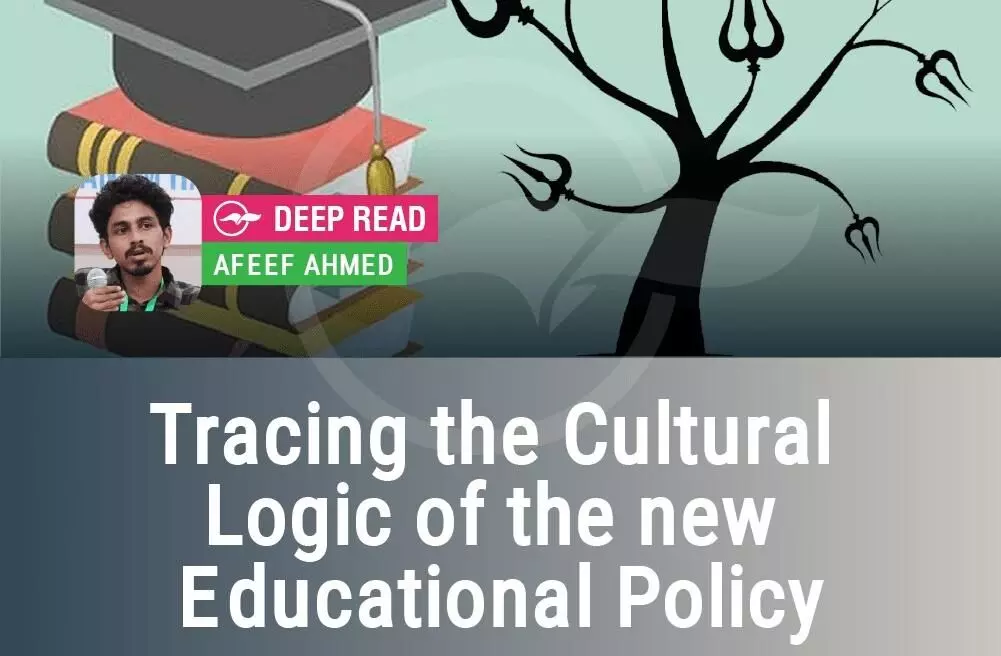
Tracing the cultural logic of the new educational policy
text_fieldsThe central cabinet ministry has approved the new education policy which includes directions and suggestions for radical reforms in the existing education policy, which had not seen many radical changes in the post-colonial era of the state. Words like change and reform are always read synonymously with the idea of progress and development.
It is under this same logic in which the liberal nationalists and national media are coming up with pieces and observations which hails the 'changes' and 'reforms' in the new education policy. It is only by problematizing the logic and language of progress which enables an (in)visible power implication that we can understand the essence of policy-level decisions, which is only possible by possession of power. When we use these words in liberal logic, we often tend to forget the fact that 'progress' is the progress and development of only a section while it further creates a rupture between the marginalized and the possibilities of mobility. Therefore, rather than looking from the angle of mere progress and development in liberal logic, it is important to assess the impact of the new education policy from a social premise wherein caste-like factors determine the fundamental socio-political and economic power dynamics of India.
Most of the suggestions and corrections put forward by citizens, academicians, state governments and political organizations were ignored and parliament in effectbypassed in the process of the central government approving the new policy. And it was also done without many seminal changes in the old draft which was made available before the public for a while. On the other hand, R.S.S-affiliated educational organizations like Bharatiya Shikshan Mandal have welcomed the new policy, stating that it has met over 60% of their suggestions. The ideological fuel behind the policy is evident from this nationwide Sangh acceptance of the policy while left-bahujan parties are opposing it.
Knowledge and Power
One of the major critiques of the policy says that it centralizes those parts of education and its implementation related to its authority, when India's constitution classifies education in the concurrent list where both the central and state governments have their proportional power over implementation. Thus, it will end up in the abuse of power implications from the top tier. In an 'over-imagined' (Ansari M.T 2016) geography like India, the de-centralization of education has its part to play. Moreover, it is this de-centralization which is seminal in resisting various kind of actions and attempts to implement a monolithic education(al) culture since the post-independent times of the nation-state.
According to the new policy, HEGC (Higher Education Grants Council) will replace the current University Grants Commission (UGC) through the HECI act. Rather than a mere change in abbreviation, this change will put autonomous higher education in jeopardy. If UGC is a committee with autonomy according to the UGC Act of 1956, when it comes to HEGC it gets transformed into a body under the control of the central government, where the members are also appointed by the government. Likewise, UGC's major role is crucial in regard to the allocation and distribution of funds in the area of higher education. When the new policy comes into effect, HEFA (Higher Education Financing Agency) will take decisions in matters related to funding in the higher education sector. This will also come under the Central Government according to the aforementioned HECI Act. In short, the decisions related to funding allocation and distribution will be in the hands of the central government.
This enormous power will have dangerous implications for survival of the very concept of public universities which are conventionally vocal and critical against the ruling regimes. Moreover, under HEFA, financial assistance will be provided mostly as loans rather than as grants. This scenario will pressurize public universities to manage/collect funds in their own chosen ways which might result in constant fee hikes, more self-financing courses, abolishing permanent teaching posts, and attracting 'philanthropic' (read private corporate) investments. All these cost-cutting measures will act as a catalyst in the process of privatization where the public-welfare character of universities will be erased. This will be the endgame of the higher educational dreams and desires of the marginalized.
This picture will get clearer when read along with the RUSA (RashtriyaUcchadar Shiksha Abhiyan) project, which has been in force for almost the past decade. One of the major final goals of the RUSA project - which functions with the assistance of the Tata Institute of Science - is the gradual de-funding (discontinuing of government grants and funds) in the higher education sector. The aforementioned are only some methods to increase the speed of the process. Likewise, the government steps back gradually from the financial responsibility of affiliated colleges by granting all-round autonomy (financial and academic) . By this, universities will move along the path of private corporates of corporate cost-cutting and maximising profit.
With the arrival of 'philanthropic' investors and constant fee hikes, universities and colleges which lack fair representation of marginalized-minority communities since its inception, will further reach unapproachable heights for the representatives of these communities. Along with this, when things come under the direct supervision of the central government, it will cause the structural transformation of the demographic proportion of students and teachers, who have been vocal against the regime to an extent, and will result in further alienation of lower caste-class, marginalized voices which are already vulnerable and suffocating under the gradual transformation of the savarna public sphere. The result of this high caste-capitalist stratification process would be the birth of a class of students and teachers who are disturbingly mechanical in their acts and extremely weak in their political imaginations and acts of dissent. The possible result of autonomy would be the abolition of unionization of both students and teachers which mysteriously coincides with a major recommendation of the Birla-Ambani Report of 2000 for the complete removal of politics from universities. Thus, universities will transform as upper-caste, apolitical and neo-liberal spaces which absorb and reproduce capitalistic logic, not independent ideas.
'Indian' Heritage and National Categories
The NEP document repeatedly harps on and celebrates visions such as 'Indian culture', 'Indian values', 'Indian tradition'. The implicit monolithic understanding of 'Indian' is not only a reflection of a muscular and totalitarian nationalistic concept but also makes it almost impossible to extract the idea of 'Indian' from the conception of 'Hindu'. As Talal Asad draws from Partha Chatterjee, 'the 'publicly recognizable personality' of the nation is strongly mediated by representations of re-constituted upper-caste Hinduism' (Asad, T 2003). This is almost evident from the suggestions and aspirations of the report. From statements such as 'The rich heritage of ancient and eternal Indian knowledge and thought has been a guiding light for this Policy' to crucial policy level suggestions, we can see the constant going back to the 'golden age' of Indian culture, which was an evident an orientalist construction. It also tries to put modern scientific advancements and medical developments along with the ancient (Vedic) tradition.
The new policy celebrates and demands the complete execution of the three language policy, which has long been advocated by RSS According to three language policy, students are compelled to study three languages (two of them native to India) till fifth grade, but preferably till Grade 8 and beyond. It may not appear as a problematic implementation at first glance, but under the deceptive surface of the policy, is a clear agenda of cultural hegemony.
In the policy, Sanskrit is deemed as an 'an important modern language' and goes on to describein two paragraphs the glories of Vedic language . According to it, Sanskrit as a language of the 'entire knowledge system' will be promoted by the central government itself along with the 'national' language Hindi, and will 'be offered at all levels of school and higher education as an important option'. When languages like Tamil and Malayalam are limited with their geographical-vernacular indicators, Hindi and Sanskrit, while having the same geographical and class indicators respectively, transcend in effect to a level of 'standard', 'modern', 'Indian' languages.
There is a riotous history of endless debates and struggles against the imposition of Hindi and its 'national' significance, especially from South Indian states. When Sanskrit also comes into this savarna ensemble of 'National-Modern-Indian', The Vedic-Brahmanic hegemony which worked as an invisible actor in the language policies and education till the date, will start to act visibly with the official support of the state and will be promoted across the geographies of the state.
Hany Babu M.T, an academician and an eminent linguist, who was recently arrested by National Investigation Agency (NIA) on the cooked up charges surrounding the Bhima Koregaon case, has effectively exposed the dangers of the three-language policy in his brilliant study titled 'Breaking the Chaturvarna System of Languages'. He argues that "both the constitutional scheme and the official language policy of the Indian state envisage not a relationship of complementation between the various languages spoken in India, but a hierarchical system". Instead of the normal arguments of 'plurality' and 'diversity', he points at the 'hierarchical'. While building up his argument, he further goes on to say talks about "several layers at which discrimination operates with Sanskrit-Hindi, the scheduled and the non-scheduled languages, all occupying various rungs of the ladder" and draws a parallel between "the linguistic hierarchy and the caste system by invoking the notion of chaturvarna".
Those who applaud the change of the medium of instruction from English to mother tongue as 'progressive' from a cognitive perspective, completely detach language from its ideological dimension. It also ignores the relevance of the English language in the social sphere of India which is strongly influenced by caste acts and (non) acts. When the standard of public education is shifting from the English language to the mother tongue, students from upper-middle class-caste- urban locations will lose nothing for they have feasible options and access to acquire what is lost through alternative means, given their social-economic-geographic advantage.
But this is not the condition of the majority of Dalits, Adivasis, and Muslim-Bahujan minorities of the state. The English language is one of the major channels for the marginalized to acquire social mobility. While acknowledging the anti-colonial positions on the language, in a society like India where caste structure is evident and manifests in the socio-cultural transactions, language has its key role to play. Dalit/Bahujan thinkers like Chandrabhan Prasad and KanchaIlaiah talk about the need to use English to empower Dalits and the marginalized sections. This is not to presuppose that the English language will liberate Dalit Bahujans by eradicating inequalities. A s Santosh Dash (2009) puts it: '"whether education is in English or the vernacular, it cultivates elitism and elitism in India has caste as one of its major constituents". While caste is an inevitable factor in the context of India, the English language, rather than the mother tongue, provides Bahujans a bridge to the international sphere, with all its aforementioned limitations. English also acts as an important arm in this way as Rita Kothari argues, "To attain a casteless society, we must enable the citizens to wield a language that has no memory of caste".
But instead of expanding the possibilities of an 'egalitarian' language, the government through the three language policy is re-invoking the violent memories of caste discrimination by bringing the Vedic language into the public sphere as a 'modern' language, along with Hindi. Moreover, the government says that the state will ensure an egalitarian approach in the choice of languages. However, given the dynamics of 'hierarchal' order of languages, as Hany categorizes it, t people speaking the language of the lower strata, will be compelled to learn the dominant, 'official' languages in the higher positions of hierarchy, not because government directly demands it but because of the evident social conditions that determine opportunities and offer fillips. At the same time, those who speak the languages ofthe higher strata of this 'Chaturvarna' system, will have no social pressure to learn lower strata languages as the dominant nature of their language will already have put them at an advantage. This should be understood with its link to the historical and gradual implementation of cultural hegemony, which has its roots in the formation of the state itself.
Merit Argument and Social Justice
While reproducing all the kinds of hegemonic notions, both culturally and economically, the report is replete with an (a)political narrativeof merit which can easily attract the urban liberal middle-class psyche. It brings in the conventional anti-reservation argument of merit, in a further nuanced way where the systematic methods of caste-based exclusions are neglected and the mere manifestations of such exclusions, such as literacy, health, and nutrition are disproportionately addressed at the cost of invisibilizing the fundamental cause.
According to a report, a 484-page document makes a solitary mention of '"reservation' and that too only to say that private institutes of higher education need not follow 'reservation' when on the contrary, the word 'merit' is mentioned around forty times in the document at various crucial points. The word caste is also nominally mentioned, as it appears in only two crucial places in a total of six times including index and glossary.
All the aptitude testing measures and the logic of common entrance tests based on merit, tend to ignore the existing realities of inequalities. It can be understood that time, in the context of India, works as a power structure. When you imagine everything in a linear space and time, you should realize that imagination is a structural violence for a Bahujan idea of time that differs from Brahmin imagination. So it is important to approach this policy from a structural level to understand the historical violence and structural injustice behind many acclaimedrecommendations. Even most of the vocal critiques of the policy who understand this as a 'singular' project of communalisation or saffronisation, often tend to ignore the very existing realities of discrimination in the higher education sector. It is important to note that these sectors officially evolve into exclusive upper-caste class spaces, when the Bahujan and minorities who have acquired social mobility have started to form new political-theoretical imagination in the university spaces in the post-Mandal period. If these new reforms are dangerous, it is also important not to forget that all these spaces have been existing by sabotaging and converting reservations and by protecting its own casteist space by maintaining caste dominations even in faculty resources.
According to the UGC Annual Report 2017-18, in 30 central universities, 95 % of Professor belong to Forward Castes while the share of ST is 1% and of OBC stands 1% and SC 3%. As all these statistics shows, Notably, this new policy is being introduced at a time when marginalized minorities and bahujans began disrupting the equilibrium of such secured fortresses of domination. This clearly shows us the notorious capability of the caste system to transcend the challenges of the 'new' without giving up the 'old', by creating a neo-caste order boosted by a neo-liberal machinery using the age-old rhetoric of progress and merit, thereby retaining hegemony.
When we look at this through the economic-deterministic lens or the lens of parliamentary politics, there are high chances that we will miss the dangerous realities of cultural hegemony and the clout of its underpinning ideology. Most of the critiques of the policy try to blame it all on the BJP and its corporate nexus at the cost of ignoring the long-term project of Savarna hegemony, both at the levels of culture and power.
This should be understood by tracing the genesis of a crucial cultural problem and the long debate rooted in the formation of the post-colonial state, or in the national movement itself. The savarna-brahmanic logic is at the one end of this debate withthe Bahujan-minority logicat the other . Most of the mainstream political formations have been bred onor influenced by this savarna-Brahmanic logic. Therefore it would amount an oversimplification to accuse a political party of all the troubles instead of blaming the ideology behind it.
As Shefali Jha (2005) observes, the aforementioned positions are clear from the constitutional assembly debates itself. This cultural hegemonic argument and logic has not only prevailed but even strengthened over time by expanding its ideological-practical reach. This policy-level shift should be understood as an ideal time of transformation for an all-round ideology to bring the political-cultural and practical public sphere of India under its cultural logic. So, criticizing it by only taking up a part of its larger framework will only help to expand the practical domain of that ideology through the other channels. Therefore, it becomes our duty to understand this ideology in all its domains and underlying logic at first, and modify our critical tools and practical resources to resist these cultural projects which come under various names.
(The author is a BA student in Hindu College, University of Delhi)
References.
- Dash, Santosh (2009): English Education and the Question of Indian Nationalism: A Perspective on the Vernacular, Delhi: Aakar.
- Kothari, Rita (2013): Caste in a Casteless Language? English as a Language of 'Dalit' Expression " Economic & Political Weekly, Vol 48, No 39.
- Hany Babu M T(2017): Breaking the Chaturvarna System of Languages:
- The Need to Overhaul the Language Policy. Economic & Political Weekly, Vol LII, No 23
- Ansari, M T. Islam and Nationalism in India: South Indian Contexts. , 2016. Print.
- Jha, S. (2002). Secularism in the Constituent Assembly Debates, 1946-1950.
- Economic and Political Weekly, 3175-3180.
- Asad, T. (2003). Formations of the Secular: Christianity, Islam, Modernity.























